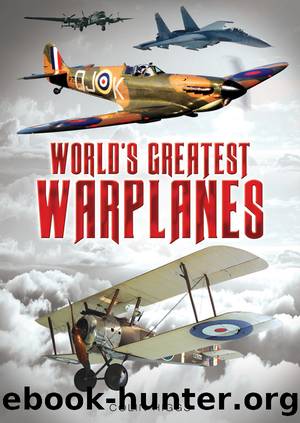World's Greatest Warplanes by Colin Higgs

Author:Colin Higgs
Language: eng
Format: epub
Publisher: G2 Rights Ltd
The Boeing B-29 Superfortress can easily be forgotten as it never served in Europe during the Second World War. However it was, by some way, the most technically advanced bomber of the war and served the USAAF through the end of the war against Japan and the Korean War that followed in 1950.
Even before the Second World War the US was looking at pressurisation for their future aircraft. Boeing’s initial plan was to pressurise the B-17 Flying Fortress but eventually came up with a new design, and it was this that was submitted for the new long-range, high-altitude heavy four-engined bomber in 1940.
Development moved slowly until the attack on Pearl Harbor on 7 December 1941 after which the pace moved up a gear. The first of two prototypes flew on 21 September 1942 but problems followed due to the complex nature of the aircraft, the difficulties of production and the speed with which the USAAF now required the aircraft.
However what emerged when it finally went into full production was a highly advanced aircraft. Responding to the requirement it was the world’s first pressurised bomber and could fly up to 31,000 feet. Pressurisation was achieved with a unique design idea. The fuselage was a tube into which was put another tube allowing crew to crawl between two pressurised areas front and back. This meant that the gun positions could not be manned, apart from the tail turret, so ten of the guns were fired by computer-assisted remote control, another first for the B-29. It could also carry a huge bomb load, up to 20,000lbs, almost five times the load of the B-17. All this helped to create the world’s heaviest production aircraft.
The B-29 went into service in 1943 but was only ever used in the Pacific theatre. Initially flying out of India they attacked Japanese targets in Thailand but soon they were spearheading the attack on Japan itself. Using their long range capabilities over the vastness of the Pacific Ocean formations of up to 1,000 bombers were soon bombing Tokyo and other major Japanese cities initially at high level in daylight but later at low level on night raids.
Download
This site does not store any files on its server. We only index and link to content provided by other sites. Please contact the content providers to delete copyright contents if any and email us, we'll remove relevant links or contents immediately.
| Aeronautics & Astronautics | Astronomy |
| Astrophysics & Space Science | Comets, Meteors & Asteroids |
| Cosmology | Mars |
| Solar System | Star-Gazing |
| Telescopes | UFOs |
Tools of Titans by Timothy Ferriss(8215)
Turbulence by E. J. Noyes(7935)
Secrets of Antigravity Propulsion: Tesla, UFOs, and Classified Aerospace Technology by Ph.D. Paul A. Laviolette(5309)
Astrophysics for People in a Hurry by Neil DeGrasse Tyson(5130)
Room 212 by Kate Stewart(5035)
Design of Trajectory Optimization Approach for Space Maneuver Vehicle Skip Entry Problems by Runqi Chai & Al Savvaris & Antonios Tsourdos & Senchun Chai(5011)
Pale Blue Dot by Carl Sagan(4909)
The David Icke Guide to the Global Conspiracy (and how to end it) by David Icke(4624)
A Journey Through Divination and Astronomy by Publishing Pottermore(4344)
Goodbye Paradise(3726)
Apollo 8 by Jeffrey Kluger(3635)
COSMOS by Carl Sagan(3553)
Losing the Nobel Prize by Brian Keating(3498)
The Five People You Meet in Heaven by Mitch Albom(3474)
How to Read Water: Clues and Patterns from Puddles to the Sea (Natural Navigation) by Tristan Gooley(3406)
Brief Answers to the Big Questions by Stephen Hawking(3369)
How to Read Nature by Tristan Gooley(3249)
The Order of Time by Carlo Rovelli(3145)
A Brief History of Time by Stephen Hawking(2959)
